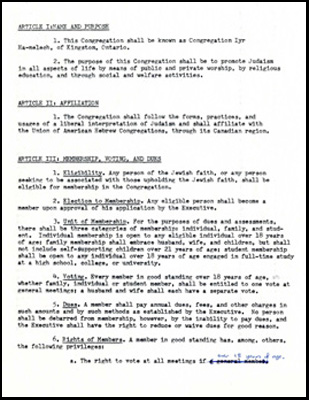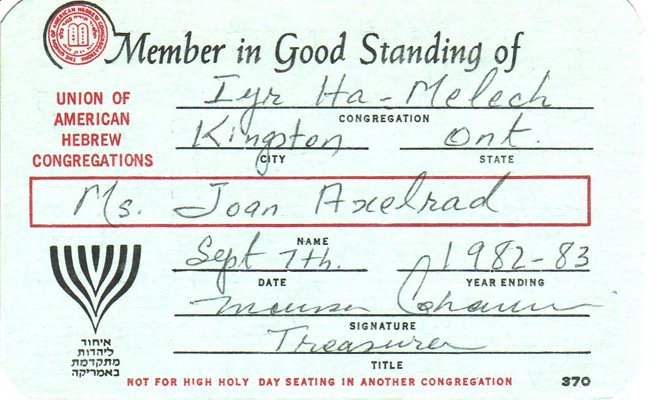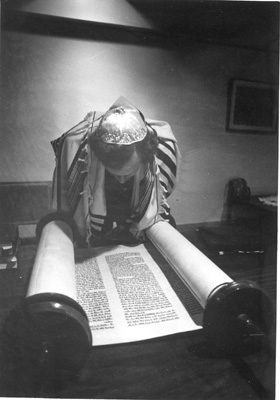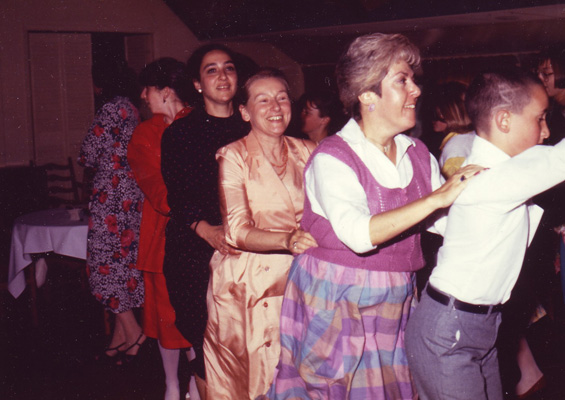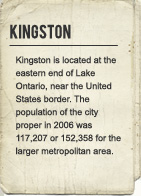Iyr Ha-Melech
A new era in Kingston’s Jewish community was launched when a Reform congregation was inaugurated, thanks in large measure to the leadership provided by Michael Levison, a recently-arrived British Jew and pioneering computer scientist at Queen’s. The initial organizing meeting was held in 1975, around Rosh Hashanah. On Friday, September 26th, the pioneering cluster of six or seven families held their first services in Dupuis Hall at Queen’s University, using prayer books donated by the Conservative movement. Different denominational options were considered, including Conservative, Reform and Reconstructionist. The group settled on Reform in the spring of 1976 and affiliated with the movement formally the following year. The new community, just under half of whom were teaching at Queen’s, called itself Iyr Ha-Melech, Hebrew for City of the King, or Kingston.
Thanks to the hard work and dedication of Michael Levison and his wife Ann, and to the core group gathered around them, the new congregation was a success. In 1985, the congregation completed the purchase of a block of plots in the Cataraqui Cemetery. In 1986, Iyr Ha-Melech President Moussa Cohanim announced in his final President’s Report, “We are here to stay.”
Between 1983 and 1993, household memberships grew from 19 to 50, an increase of 163%. Iyr Ha-Melech held Shabbat and holiday services and prepared young people for their bar and bat mitzvahs. It also put out a newsletter, “The Iyr Ha-Melech Whig,” including lively and thoughtful content supplied by different professors and other members. They also offered Hebrew classes to the children and Ann Levison ran the Hebrew School. Finally, they offered innovative programs such as the Women’s Study Group and an active Social Action Committee.
By 1990, the need for a building was being felt but the group had made it part of their identity not to have one. Cost had been a consideration but so was the sense of freedom to focus on the essentials of Jewish life and community without being tied to the worries and responsibilities of owning and maintaining a building. Feelings were strong. The congregation met at 391 Barrie Street and in 1992, they almost bought a building, but in the end, it did not work out. However, pressure within the community continued to grow. Even the children got involved as when, in 1995, 38 students from the congregation’s Hebrew school signed a petition in favour of a building to house the synagogue and also a school and community centre. In January of 1996, a special meeting was called to take up the question again. Advantages and disadvantages were discussed and a motion was passed committing the congregation to the principle of purchasing a building, but the project did not come to fruition. Although this congregation still does not have its own building, it is today a “full-service shul,” offering religious services, celebration of life cycle events from brit milah to burial, religious school for the children, adult education, a social action committee, which reflects their commitment to tikkun olam, and an active women’s study group that hosts a special seder for women each year.
Michael Levison resigned after a dozen and a half years of dedicated service to the congregation. After him, services were led by rabbis who came from Toronto such as Ed Elkin, Paul Golumb and Barbara Borts, who served the community by visiting on a monthly basis. Rabbi Justin Jaron Lewis, a Jewish Studies professor at Queen’s, was the congregation’s spiritual leader from 2000 through 2007. The current rabbi is Michal Shekel, who remains a resource for the community from her base in Toronto. In addition to her work in Kingston, Rabbi Shekel is an active teacher, writer and administrator and has served as a congregational rabbi in Toronto, London, Waterloo, Boston, and New Jersey.


